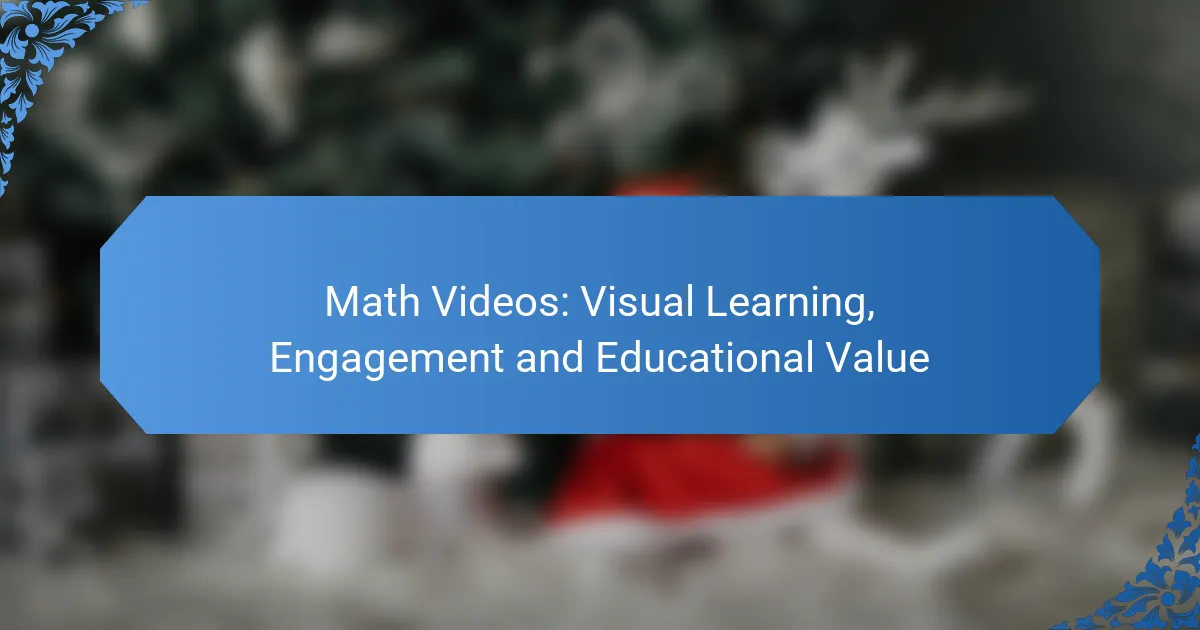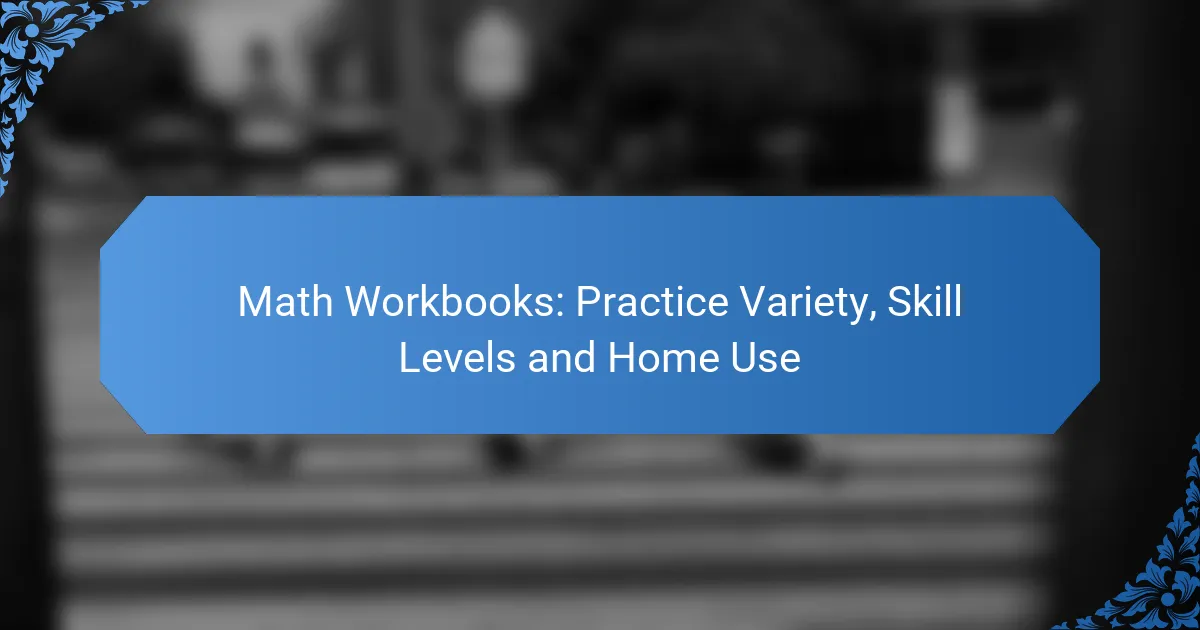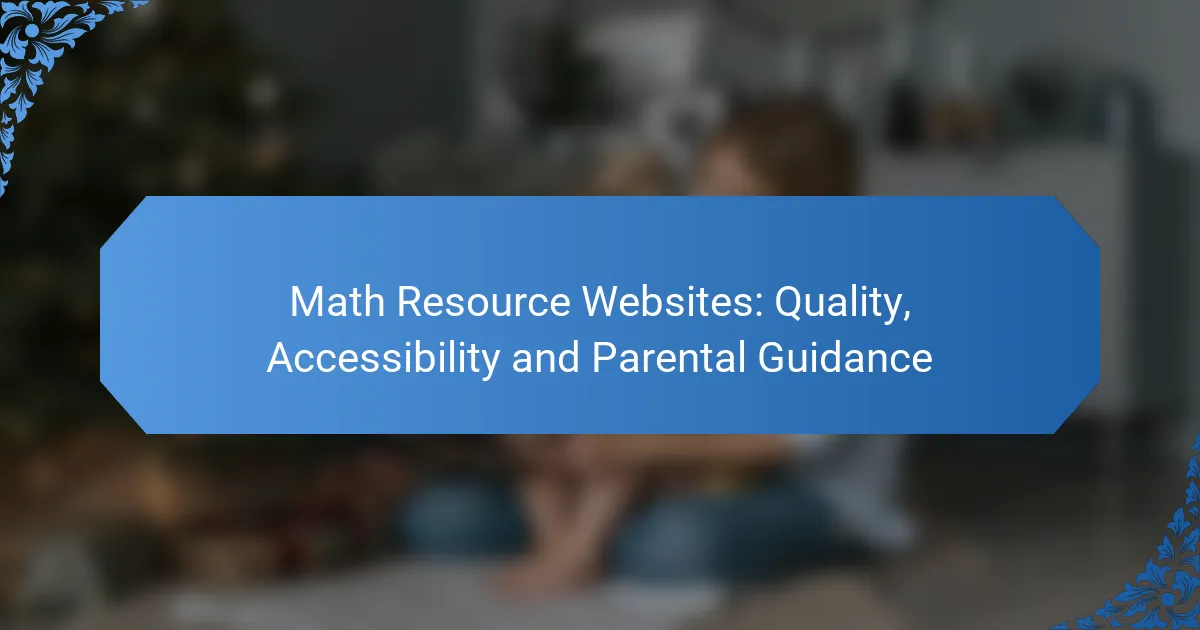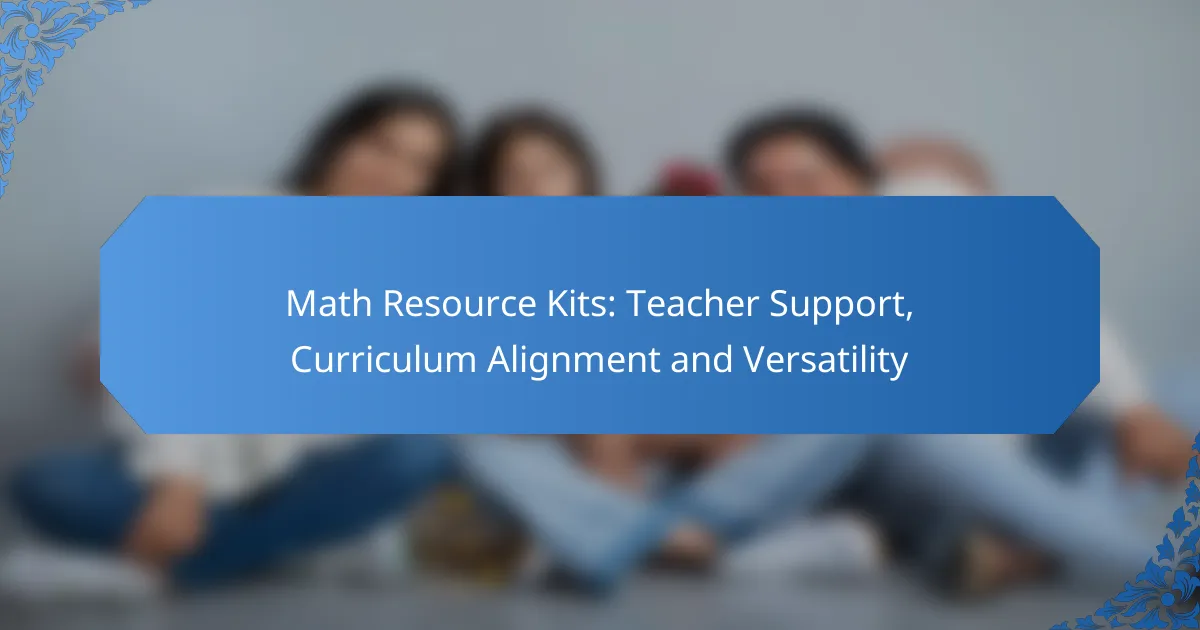Math videos serve as powerful tools for visual learning, transforming complex concepts into easily digestible content through engaging animations and real-world examples. By catering to diverse learning styles, these videos not only enhance understanding but also improve retention, making math more accessible and enjoyable for students. Platforms like Khan Academy, Coursera, and edX offer a wealth of resources tailored to various educational needs, further enriching the learning experience.
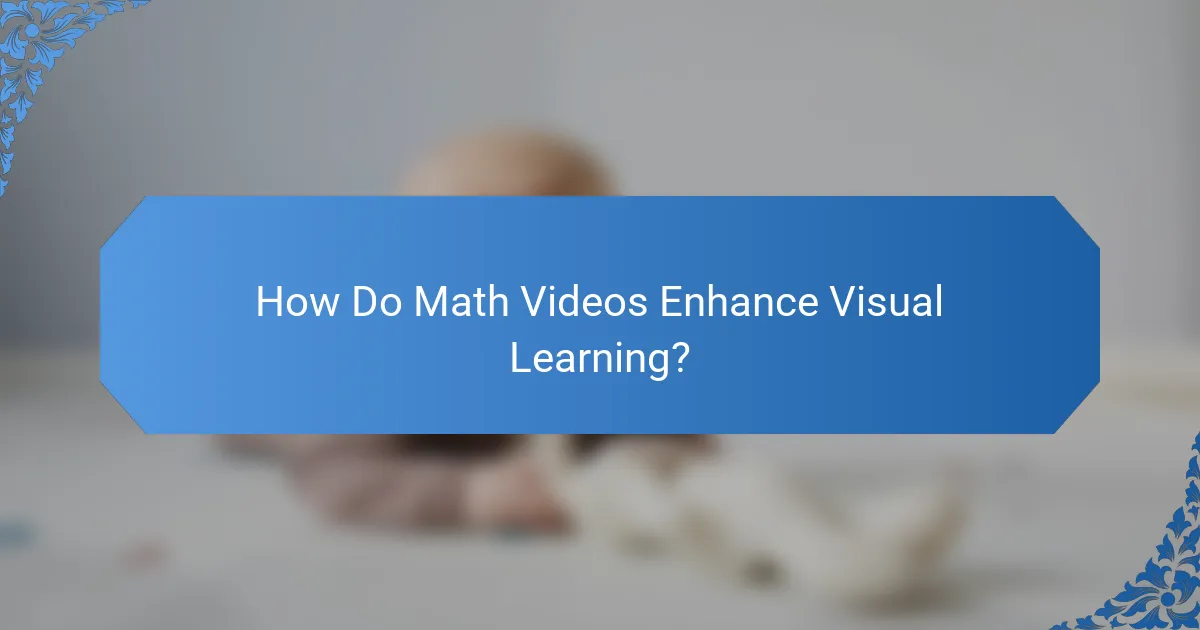
How Do Math Videos Enhance Visual Learning?
Math videos enhance visual learning by providing dynamic visual aids that simplify complex concepts. These videos engage learners through animations, diagrams, and real-world examples, making abstract ideas more tangible and easier to understand.
Visual representation of concepts
Visual representation in math videos allows learners to see concepts in action, which can clarify difficult topics. For instance, a video might show the process of solving a quadratic equation using graphical representations, helping students visualize the relationship between the equation and its graph.
Using color coding and animations can further enhance understanding. For example, different colors can represent various components of a problem, making it easier for students to follow along and grasp the underlying principles.
Improved retention through engagement
Engagement is key to retention, and math videos often incorporate storytelling elements or interactive quizzes to keep viewers interested. This approach can significantly improve memory recall, as learners are more likely to remember information presented in an engaging format.
Studies suggest that learners who watch interactive math videos retain information better than those who rely solely on traditional textbooks. Incorporating questions throughout the video can prompt viewers to think critically and apply what they have learned, reinforcing their understanding.
Real-world applications of math
Math videos often illustrate real-world applications, making the subject more relevant and interesting. For example, a video might demonstrate how algebra is used in budgeting or how geometry is essential in architecture, connecting classroom learning to everyday life.
By showcasing practical uses of math, these videos can motivate students to see the value in what they are learning. This relevance can inspire learners to pursue further studies in math or related fields, knowing that the skills they acquire have tangible benefits in the real world.
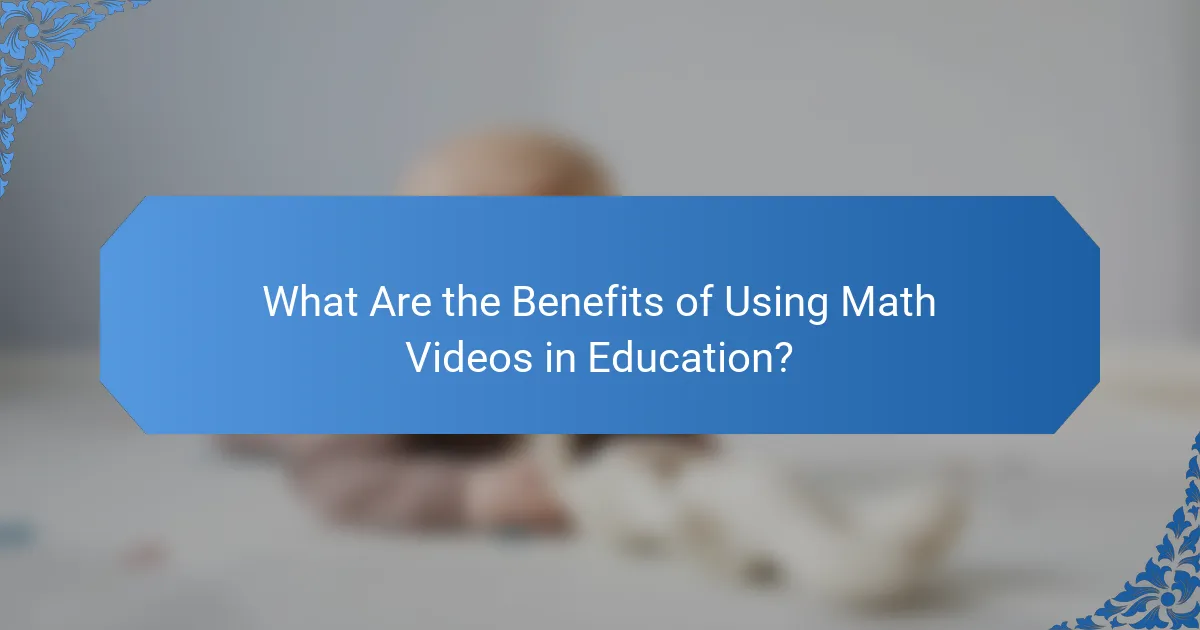
What Are the Benefits of Using Math Videos in Education?
Math videos enhance education by providing visual learning tools that improve understanding and retention. They engage students in a dynamic way, making complex concepts more accessible and enjoyable.
Increased student engagement
Math videos capture students’ attention through engaging visuals and storytelling techniques. This multimedia approach can significantly increase interest in math topics, leading to higher participation rates in lessons.
For example, animated explanations of mathematical concepts can make learning feel more like entertainment, which can motivate students to explore subjects they might otherwise find daunting. Incorporating interactive elements, such as quizzes within videos, further boosts engagement.
Flexible learning pace
Math videos allow students to learn at their own pace, accommodating different learning styles and speeds. Students can pause, rewind, or rewatch sections to fully grasp challenging concepts, which is often not possible in a traditional classroom setting.
This flexibility is particularly beneficial for students who may need extra time to understand specific topics or for those who wish to advance more quickly. For instance, a student struggling with fractions can focus on that topic until they feel confident before moving on.
Accessibility for diverse learners
Math videos provide valuable resources for diverse learners, including those with different language backgrounds or learning disabilities. Visual aids and clear explanations can help bridge gaps in understanding, making math more inclusive.
Subtitles and translations can further enhance accessibility for non-native speakers, while visual representations of problems can assist students with dyslexia or other learning challenges. Schools can utilize platforms that offer a variety of video formats to cater to these diverse needs effectively.
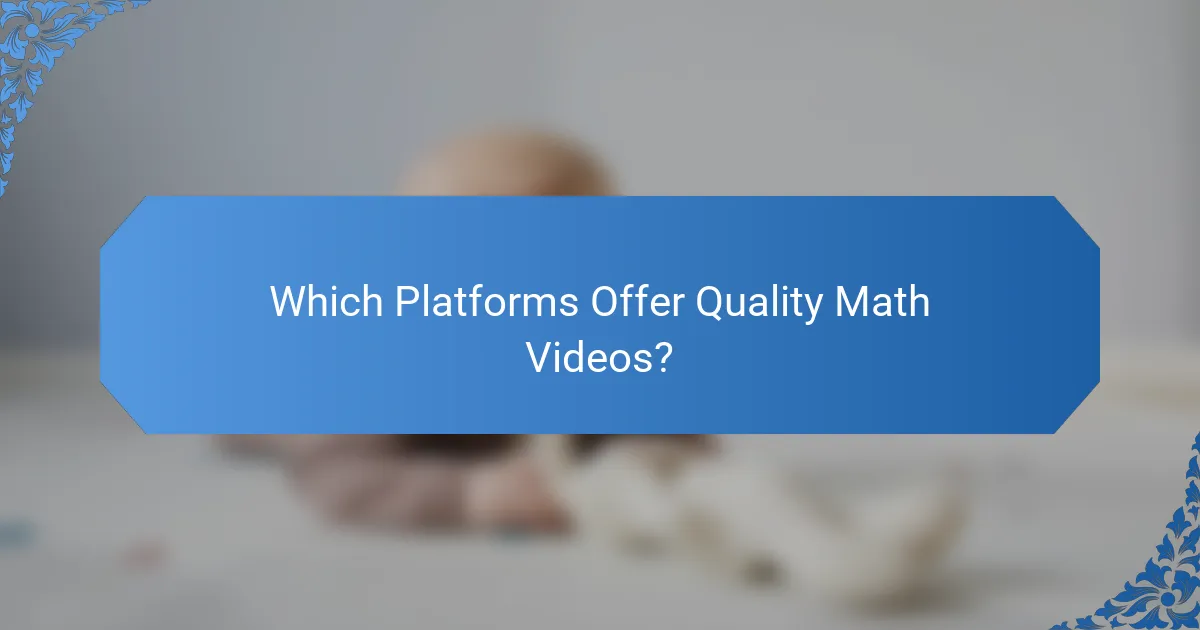
Which Platforms Offer Quality Math Videos?
Several platforms provide high-quality math videos that cater to different learning styles and needs. Khan Academy, Coursera, and edX are among the most notable, each offering unique features and resources for learners at various levels.
Khan Academy
Khan Academy is a free educational platform that offers a vast library of math videos covering topics from basic arithmetic to advanced calculus. The videos are designed to be engaging and interactive, often accompanied by practice exercises to reinforce learning.
One of the key advantages of Khan Academy is its personalized learning dashboard, which allows users to track their progress and focus on areas needing improvement. This feature is particularly beneficial for students who may struggle with specific concepts.
Coursera
Coursera partners with universities and organizations to provide high-quality math courses that include video lectures. While many courses are free to audit, obtaining a certificate usually requires a fee, which can range from $30 to $100 depending on the course.
Courses on Coursera often include peer-reviewed assignments and community forums, enhancing the learning experience. This platform is ideal for learners seeking a more structured approach to math education, often aligned with academic standards.
edX
edX offers a range of math courses from top universities, featuring video content that is both informative and engaging. Like Coursera, edX allows users to audit courses for free, with the option to pay for verified certificates.
edX courses often include interactive elements such as quizzes and discussion boards, fostering a collaborative learning environment. This platform is suitable for those looking to deepen their understanding of mathematical concepts while benefiting from university-level instruction.

How to Choose the Right Math Video Course?
Choosing the right math video course involves assessing the course content, instructor qualifications, and user feedback. Prioritize these factors to ensure a comprehensive and engaging learning experience.
Evaluate course content quality
Start by reviewing the curriculum to ensure it aligns with your learning goals. Look for courses that cover essential topics in depth, such as algebra, geometry, or calculus, and check if they offer practical examples and problem-solving strategies.
Consider whether the course includes interactive elements, such as quizzes or practice exercises, which can enhance understanding and retention. A well-structured course typically provides a clear progression from basic to advanced concepts.
Check instructor credentials
Investigate the qualifications of the instructor to ensure they have relevant expertise and teaching experience. Look for their educational background, professional experience in mathematics, and any certifications that demonstrate their proficiency.
Instructors with a track record of successful teaching or those who have published work in the field may offer more valuable insights. Watching introductory videos can also give you a sense of their teaching style and effectiveness.
Consider user reviews and ratings
User reviews and ratings provide insight into the course’s effectiveness and engagement level. Check platforms like Udemy or Coursera for feedback from previous students, focusing on comments about the clarity of explanations and the overall learning experience.
Look for courses with high ratings and a substantial number of reviews, as these are often more reliable. Be cautious of courses with few reviews or overly positive feedback that seems generic, as they may not reflect the true quality of the course.
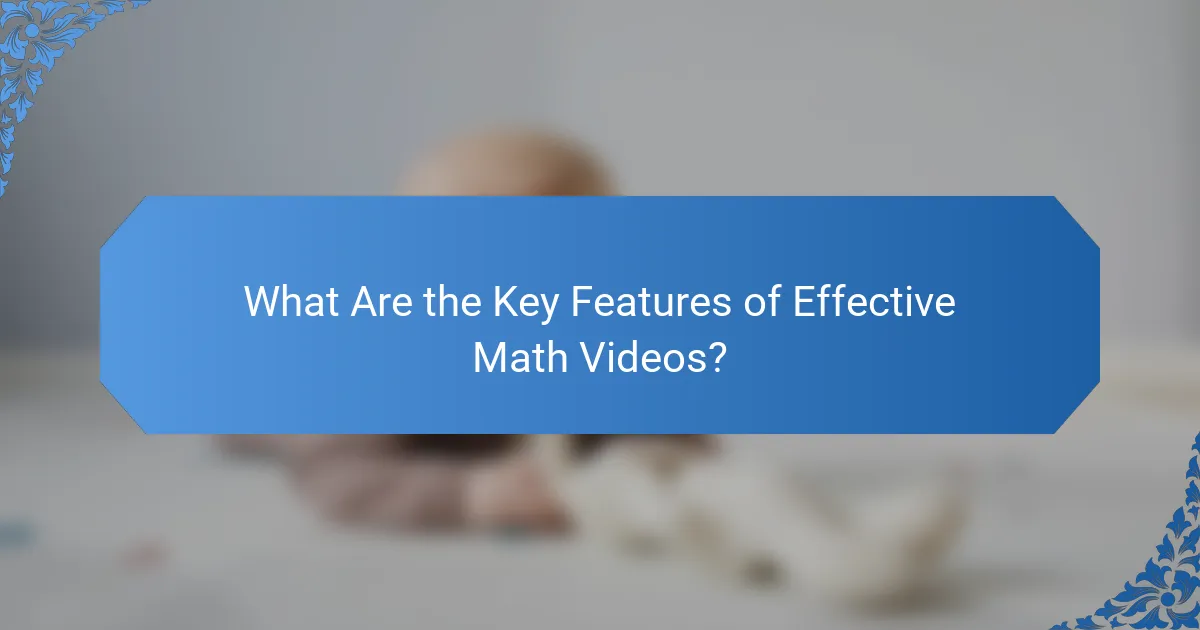
What Are the Key Features of Effective Math Videos?
Effective math videos combine engaging visuals with clear explanations to enhance understanding and retention. They often include interactive elements and structured lesson plans to facilitate active learning and keep students motivated.
Clear explanations and visuals
Clear explanations paired with visuals are essential for effective math videos. Using diagrams, animations, and real-world examples helps illustrate complex concepts, making them more accessible. For instance, a video explaining fractions might use pie charts to visually represent how parts relate to a whole.
When creating or selecting math videos, ensure that the visuals complement the spoken or written content. This synergy aids in reinforcing learning and helps students grasp abstract ideas more concretely.
Interactive elements and quizzes
Incorporating interactive elements and quizzes can significantly boost engagement in math videos. Features like pause-and-answer questions or interactive problem-solving tasks encourage viewers to actively participate rather than passively watch. This approach can lead to better retention of mathematical concepts.
Consider using platforms that allow for real-time feedback on quizzes. This immediate assessment helps learners identify areas needing improvement and fosters a more personalized learning experience.
Structured lesson plans
Structured lesson plans are crucial for guiding students through math topics systematically. Effective math videos should follow a logical progression, starting with foundational concepts and gradually introducing more complex ideas. This structure helps learners build confidence as they advance through the material.
When designing lesson plans for math videos, outline key objectives and ensure each video aligns with educational standards. For example, a series on algebra might start with basic equations before moving on to inequalities and functions, ensuring a coherent learning path.

How Do Math Videos Compare to Traditional Learning Methods?
Math videos often enhance learning by providing visual and auditory stimuli that traditional methods may lack. They can engage students more effectively and cater to various learning styles, making complex concepts easier to grasp.
Engagement levels
Engagement levels in math videos tend to be higher than in traditional classroom settings. Videos use dynamic visuals, animations, and interactive elements that capture attention and maintain interest, which is crucial for effective learning.
For example, a well-produced math video can illustrate a concept like fractions using colorful graphics and real-world applications, making it more relatable than a textbook explanation. This multimedia approach can lead to better retention of information.
To maximize engagement, educators should select videos that are concise, relevant, and interactive. Avoid overly lengthy videos, as attention spans can diminish quickly; aim for videos that are around 5 to 10 minutes long for optimal focus.
